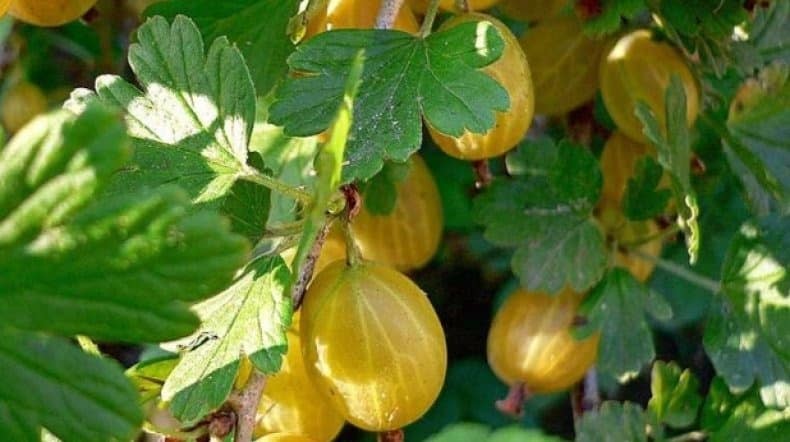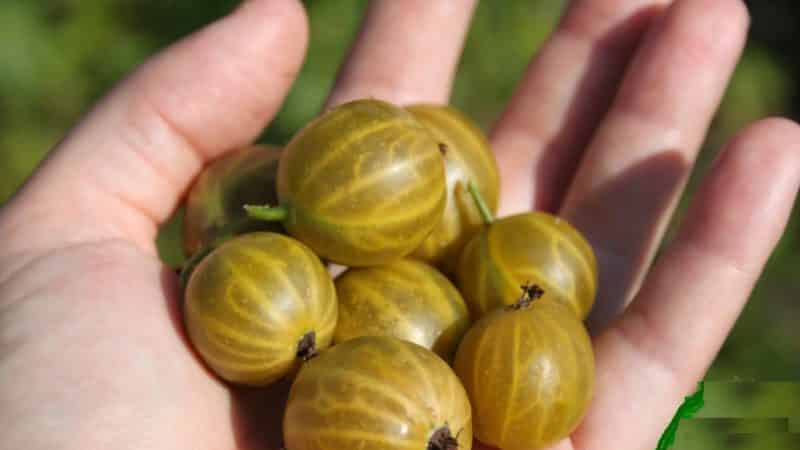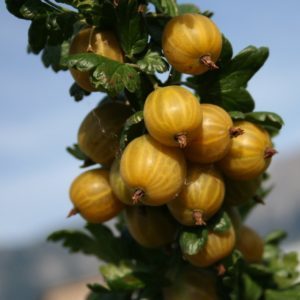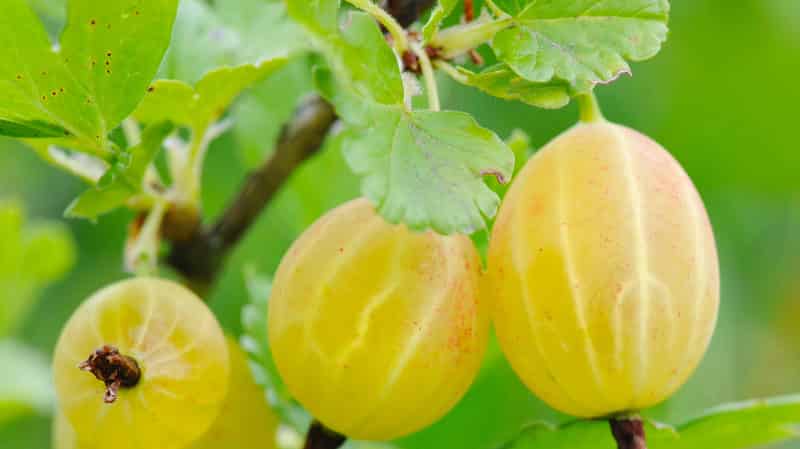Mid-early gooseberry variety Honey
Gooseberries are one of gardeners' favorite berries. There are many varieties of this plant, one of them is the mid-early Honey. It is distinguished by its amber color, increased sugar content of fruits and high productivity. We will consider the characteristics of the variety and cultivation technology in detail.
Description of the variety

Honey gooseberry is a shrub with bright yellow, almost orange berries. Their skin is thin, and the flesh is juicy and very sweet.
History of origin and distribution
This gooseberry was bred by breeders from VNIIS named after. Michurina from the American variety Purmen by pollination with European relatives (Phoenix, Industry, Green bottle, Careless). The plant was never included in the State Register of Breeding Achievements.
Important! Honey gooseberries are sometimes described as thornless. This is not true - there are many prickly and sharp thorns on the branches of the bush.
Due to the high varietal qualities of the fruit and resistance to various climatic conditions, the crop has become widespread in Russia.
Characteristics and description of bushes
Honey is a powerful, slightly spreading shrub up to 1.2–1.5 m high. The bark is gray-brown, abundantly covered with strong thorns. There is a lot of greenery, the leaf blade is three-lobed with pubescence on the underside.
The berries are round or drop-shaped, bright yellow, weighing 4.5–6.0 g. There are few seeds.
Temperature resistance
Honey has become widespread due to its hardiness - it can easily tolerate frosts down to -30°C without shelter.At even lower temperatures, it needs to be wrapped in foam rubber or burlap. In the northern regions, after autumn pruning, the branches are bent to the ground and secured with thick wire. The fallen snow will reliably protect the bush from frost.
In hot climates, Honey tolerates high temperatures up to +30°C, but requires additional watering.
Moisture and drought resistance
Gooseberries of the Honey variety grow well in moderately moist soils, but do not like soil that is too heavy and has poor drainage. Does not tolerate drought well.
Reference. Beekeepers value gooseberries as an early honey plant (the shrub blooms in the spring).
If there is a lack of moisture, the plant drops the resulting fruits. For this reason, it is not grown by agricultural enterprises in southern Russia. In private farmsteads, with regular watering, Honey produces up to 4.5–6 kg of berries per bush.
Characteristics and description of fruits

Honey gooseberry berries are large, round or drop-shaped, weighing about 4.2–6 g. The color ranges from bright yellow to orange, there is no pubescence. A light tan forms on the side facing the sun. The skin is thin. The pulp is juicy, sweet, with a light honey aroma and taste. There are few seeds.
Areas of use
Gooseberries are widely used in cooking. They are used to prepare preserves, jams, confitures, marmalades, preserves. The fruits store well frozen.
Reference. In folk medicine, berries are used as a diuretic and laxative.
Honey fruits are suitable for transportation. At a temperature of +12...+15°C, they are stored for 1.5–2 weeks without loss of commercial quality.
Advantages and disadvantages of the variety
Honey has many advantages:
- high productivity;

- excellent commercial quality of fruits;
- frost resistance;
- increased content of sugars (20% of weight) and vitamin C (3 g per 100 g of berries).
The disadvantages include:
- demands on soil, moisture, fertilizers;
- vulnerability to pests;
- the need for regular pruning;
- a large number of thorns making harvesting difficult.
The calorie content of gooseberries is only 44 kcal. Therefore, it is recommended for overweight people to eat it.
Growing technology
If agricultural practices are followed, Honey produces a generous harvest and longevity. In one place, the bush grows and bears fruit for up to 30 years without losing the commercial qualities of the berries.
Optimal conditions
Honey grows well in temperate and temperate continental climates, on well-drained neutral or slightly acidic soils. When overwatered, it suffers from fungal infections. diseases, with a lack of moisture, sheds the ovaries. Cannot tolerate shade or partial shade.
Healthy! Berries contain a lot of pectins, which cleanse the gastrointestinal tract.
Landing dates and rules
Honey is planted in early spring or autumn. The place for the bush is chosen on a hill, well lit by the sun. Lack of shading is an important condition.
The soil is prepared in advance. The earth is dug up to the depth of a bayonet, choosing weeds and roots. At the same time, organic fertilizers are added - humus, manure.
Seedlings are selected that are strong, healthy, with at least 3 taproots 25–30 cm long. The fibrous root system must be well developed. The above-ground part consists of 2-3 shoots, the bark is without damage or traces of damage.
Before planting, the roots are disinfected in a weak solution of potassium permanganate for 24 hours to protect the plant from diseases.
A hole for a seedling is prepared with a depth of 40–50 cm and a width of 55–60 cm. An interval of 1.2–1.5 m is maintained between plants, and 1.5–2 m between rows.
Further care
To form a healthy, developed bush, gooseberries need watering, fertilizing and pruning.
Water the plant once every 2 weeks, using at least 3 buckets per 1 m². All water is supplied to the roots, sprinkling is excluded. During the formation of ovaries and fruiting, the frequency of irrigation is increased to 1 time per week. At the same time, waterlogging is not allowed.
Recommended fertilizer application rates:
- Every year in the spring, when digging, add urea (1 tbsp per 1 m²);
- Once every 2 years, on the eve of bud opening, use organic matter;
- when ovaries form, “Nitrophoska” is required;
- after harvest - organic matter or superphosphate.
Twice a year, Honey is thinned out - in early spring and autumn, dry branches and excess shoots are thickened and removed.
After each watering, the soil under the bushes is loosened and dug up, while getting rid of weeds.
Disease and pest control
The most common cause of bush death is powdery mildew. But Honey is quite resistant to it. Danger awaits gardeners when the soil becomes waterlogged, which makes the shrub vulnerable to root rot. Therefore, the plant is provided with good drainage and aeration.
Get rid of weeds in a timely manner, loosen the soil, and do not plant gooseberries in the shade or in areas poorly lit by the sun.
Pests dangerous to the crop:
- the sawfly infects greenery, completely destroying the leaves;
- the moth lays eggs during the formation of buds, which leads to rotting of the fruit;
- spider mites lead to the death of leaves and shoots;
- the scale insect attacks branches and shoots;
- aphids (shoot or leaf gall) settle on the above-ground parts of the plant, leading to deformation of leaves and branches.
To protect plants, preventive measures are carried out in a timely manner. Majority pests and gooseberry diseases, gardeners acquire them along with seedlings. Therefore, the main rule is to buy plants only from certified and trusted nurseries. Gooseberries can be propagated independently only from completely healthy bushes.
If there is a danger of infection, culture before budding process Nitrafen solution. It is prepared at the rate of 300 g per 10 liters of water. A 5% solution of iron sulfate helps a lot.
In the summer, but no later than a month before harvest (on average until mid-late June), when infested with aphids, Honey is treated with karbofos (1 tablespoon per 10 liters of water).
To protect plants from mites, remove affected shoots and pluck out swollen buds.
Wintering
In preparation for the cold period, the tree trunk is cleared of dead leaves (eggs and larvae of pests remain on them), and dry and old branches are cut out. The garbage is burned. The soil is loosened and sprinkled with sawdust.
In temperate climates, the branches are collected into a bunch and tied. This will protect them from breaking out in heavy snow and winds. To protect against rodents, the lower part of the bush is wrapped in sackcloth.
Reproduction

To form new bushes, three main methods are used:
- Gooseberries tolerate division in autumn well. This method is used when you want to transplant a plant to another place or for very overgrown specimens. The bushes are divided every 5 years to increase yield.
- Cuttings - the most difficult and lengthy reproduction procedure. At the beginning of summer, several young shoots with 5-6 leaves are cut. The lower cut is made oblique, the upper cut is horizontal. At a distance of 7–10 cm, the cuttings are planted in a greenhouse or greenhouse and covered with glass or plastic jars. Water as the soil dries out.For the winter, the jars are removed and the cuttings are covered with acrylic and sawdust. In the spring, they are transplanted to a permanent place, leaving only the top 3 buds above the ground.
- Layerings. One-year-old shoots of an adult bush (5–7 pieces) are bent to the ground, placed in grooves 8–10 cm deep, sprinkled with earth and watered. Gradually, roots and vertical shoots form on the branches. During the growing season, the cuttings are watered and sprinkled with humus 1-2 times per season. After the leaves fall, the resulting vertical branches with roots are separated from the cuttings and rooted in a permanent place.
The easiest way is to divide the bush. As a result of such actions, two plants are obtained from one plant, while when propagated by cuttings and layering, several dozen new bushes are obtained, but these methods are time-consuming and labor-intensive.
Features of cultivation depending on the region
In the south of the country, Honey needs additional watering and mandatory shelter for the winter. Winter temperatures in the southern regions drop to -20°C, and there is usually little snow. Under such conditions there is a risk of freezing.
In the northern regions, high snowdrifts reliably protect shrubs from frost.
Pollinator varieties
Honey gooseberry is self-pollinating, so it does not require planting additional varieties. Bees and bumblebees serve as pollinators for the plant.
Reviews from summer residents
Gardeners positively characterize the Honey variety. It is unpretentious in care, prolific, produces a harvest earlier than other relatives, and its jam has an exquisite aroma and a light honey taste.
Valentina Nikolaevna, Saratov: “I only planted Honey 3 years ago, but I have already reaped a good harvest. The bush is not picky, the berries are beautiful and tasty.This year I made jam - it turned out golden-amber, very tasty and aromatic.”
Alexander Viktorovich, Moscow region: “According to some reviews, Honey Yellow gooseberries are thornless, but in fact there are quite a lot of them, and this makes it difficult to harvest. However, the variety ripens earlier than others on the site and looks very beautiful: the branches are literally strewn with yellow berries. The taste lives up to the name of the plant. I have 5 grandchildren, so there are no berries left for jam - they eat everything straight from the bush, despite the thorns.”
Conclusion
The mid-early gooseberry variety Honey is suitable for various regions, but grows best in temperate climates. The shrub is cold-resistant, but does not tolerate waterlogging and drought.
The berries are unusual - bright, sunny. Taste and aroma with a slight honey tint. Increased sugar content and high content of ascorbic acid make the fruits very valuable. Growing Honey is not difficult, and it produces excellent yields.